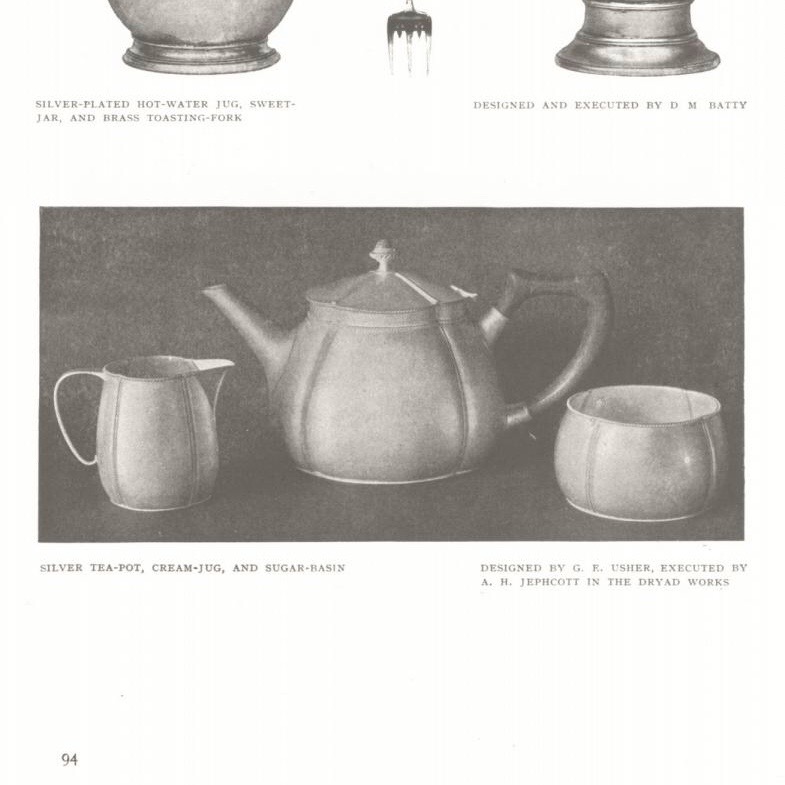An Albert Henry Jephcott (Dryad) arts and crafts silver jug
Price range: Sold
An outstanding quality silver milk jug by the little known Albert Henry Jephcott, a central, if obscure, figure in the Leicester arts and crafts movement. Birmingham 1945.
I bought this jug, and the accompanying sugar bowl (A778a), thinking they were marked for A H Jones, possibly a late piece by Bernard Cuzner’s one time partner from 1902-4. As they say “better lucky than smart”, as my research shed light on a new area of the Leicester arts and crafts movement, my home town.
This jug is by Albert Henry Jephcott of A H. Jephcott & Sons, 1 Regent Street Leicester. The mark was registered in 1937 and almost certainly relates to Albert Henry senior (1885-1955) – his same named son (1903-1976) is listed in 1939 as an “electrical radio engineer”. Albert Henry senior was a top, arts and crafts silversmith and the quality of this jug would also suggest he is the maker.
Albert Henry Jephcott senior first appears in the 1906 Arts and Crafts Exhibition Society, helping Robert Emerson execute item 297, a “bronze gong” exhibited by Collins & Co, forerunner of Dryad Metal Work. Emerson was at the Leicester School or Arts and most likely Jephcott was still a student at this point.
By the 1912 Arts and Crafts Exhibition Society Jephcott is listed as both a designer and silversmith for Dryad Metalwork, working for Harry Peach (Exhibits 31b, silver muffineer; 393 silver spoon). No doubt Jephcott continued working with Dryad (the 1917 Studio Yearbook features a tea set he executed for Dryad, page 94), but his main occupation c 1912-1920 appears to be as a teacher of jewellery and metalwork at Leicester School of Arts and Crafts (by then Leicester Technical College) working under Sidney Reeve. In c. 1926 Jephcott produces a pamphlet published by Dryad “Simple Jewellery” where he is described as “for many years” a teacher for Leicester Education Committee, and “formerly of Dryad Metal Work”. See images.
In around 1920 he sets up a Leicester jewellers and silversmiths, registering the mark AHJ&S, for A H Jephcott & Sons. Some silver is known from this period and is identical to that of Dryad – see a spoon on page 429 of Simon Moore’s “Artists spoons and related table cutlery”.
Quite what happens to the firm is unclear – I have a hypothesis that it closed in 1937, hence the further addition of this personal Jephcott “AHJ” mark, as on this bowl. In the 1939 “England Wales register” Jephcott senior describes himself as a “Silversmith and metalwork teacher” suggesting his commercial retail business is demised. Several pieces of silver from the 1940’s are known (erroneously ascribed to A H Jones) marked with AHJ for Jephcott. All these pieces, including this bowl and jug, are of a very heavy gauge, in the Birmingham/Leicester style and hint at both the passing arts and crafts movement and future 1950’s modernism. One known tea set is also marked for “Leicester School of Arts” proving Jephcott’s link was still in place even at this later date.
I would welcome anyone with further information contacting me to complete this record. Thanks to Craig O’Donnell of the Birmingham assay office and others for their help in conducting this research.
This is a wonderful piece of hand raised and planished silver of good gauge. Highly recommended!
Maker: Albert Henry Jephcott (Senior)
Designer: Albert Henry Jephcott (Senior)
Date: 1945
Marks: AHJ, Birmingham, V
Material: Sterling silver
Condition: Excellent
Size: 8.0 cm height
Weight : 186 grams, 6.6 oz
Additional Information
The Leicester School of Art was a hot spot for the of arts and crafts movement at this time. The School boasted Ernest Gimson as a student in the 1890’s (his earliest architectural commissions are in Leicester). The School was headed in 1900 by Benjamin Fletcher (up until 1920 when he moved to head the Birmingham School of Art) who, with Harry Peach, founded Dryad (Furniture) in 1906 and then Dryad Metalwork in 1911. Dryad was one of the more successful and enduring 20th century arts and crafts ventures famed for its cane work furniture and metalwork.
Most significantly, Sidney Reeve of the Guild of Handicraft was appointed head of metalwork in around 1907 and he built up a thriving silversmith’s course.
| Period | Art nouveau, Arts and crafts |
|---|





